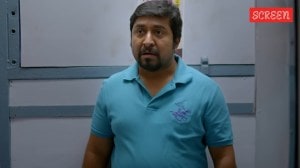The Importance of Being Obrist
He is a rockstar among international art curators and he is coming to India. In conversation with Hans Ulrich Obrist.
He is a rockstar among international art curators and he is coming to India. In conversation with Hans Ulrich Obrist.
When he was 23,he curated a show of contemporary art in his kitchen in St Gallen,Switzerland the artists he showed included Christian Boltanski and David Weiss. Two decades on,Hans Ulrich Obrist is a rockstar among art curators,named the most influential person in the art world by Art Review Magazine in 2009.
Curators are known to be anonymous behind-the-scene recluses,but Obrist fast-talking,articulate and insightful has broken out of that mould. His innovative shows,mounted at the unlikeliest of places,from monasteries to museums; his Brutally Early morning salon (it meets at 6.30 am); and The Interview Project,his epic project of conversations have made him one of the art worlds most exciting and famous men.
Since his 20s,Obrist has curated some 150 exhibitions internationally; and has been co-director of the Serpentine Gallery in London,for over four years now. The 42-year-old is heading to India,in time for the India Art Summit this month,to take his project of interviews further. Obrist has interviewed some of the most talented artists,architects,scientists,engineers and thinkers of the world,from artist Jeff Koons to Yoko Ono,artist John Baldessari to architect Rem Koolhaas. They add up to nearly 2,000 hours of wide-ranging conversations,and are saved in his personal archive two 1,000 page volumes of the conversations have been released.
In Delhi,he will conduct his signature interviews with 25 Indian artists and intellectuals: from photographer Homai Vyarawalla to artists Subodh Gupta and Bharti Kher; writer Dilip Simeon to art critic Geeta Kapur. The interviews will culminate in a book and CD to be launched later in the year. He spoke to The Indian Express over the phone from London. Excerpts:
This wont be your first visit to India. What are your expectations from this trip?
I have come to India many times before. I recall my visit in 2007 when I began the process of putting together the Indian Highway exhibition that opened at the Serpentine Gallery in London in 2008,and that had I co-curated with Julia Peyton-Jones,director,Serpentine Gallery. The exhibition is currently touring Denmark,Norway,Rome,France,Brazil,Hong Kong and Moscow. For me,its all about meeting new people. One needs to go to a place many times to get a deeper understanding of its culture. One begins by knowing the artists,since that is my field of expertise,but over time it is important to widen ones search to other areas of interest and disciplines,and look at architects and scientists. These are just early days and I see myself making many more trips to know India better.
What do you make of the journey Indian art has taken to reach this point today?
People talk a lot about India arriving on the global stage in the last five years. Actually,Indian art has been exciting for many decades I would say even about 50 years ago,when the pioneers of Indian art made their first trips out of the subcontinent. However,this is an important moment for Indian art since it is getting international recognition. But when there is an exclusive focus on young artists,one must protest.
How did you choose the participants for the marathon interview sessions you plan to conduct in Delhi?
It was a joint project by Pooja Sood of Khoj and me. We hope to capture the complexity of Indian art by mixing it up a bit,so we have architects,filmmakers artists and critics. Its like creating a pool of knowledge.
Tell us a little about your personal journey,from that first show in your kitchen when you were only 23.
In the mid-1980s,I started to meet many artists and began my research in art. The research was not done sitting at a desk but through a grand tour of Europe. Then I held my first exhibition in a kitchen,it was a do-it-yourself show and it was well received and that gave me the impetus to apply for a grant. I got the Cartier Foundation award and travelled to France.
After that,I wanted to become more familiar with Asian art and widen my scope geographically. I was invited by the Musée dArt Moderne de la Ville de Paris to organise exhibitions that would migrate to different cities. My first significant exhibition was called Manifesta 1 (a roving biennal of contemporary art) that in its first edition was held in Rotterdam. Then I began curating for the biennals.
I also realised at the time that there were hardly any in-depth publications on art and so I started The Interview Project,which became a central part of my research programme. The interviews were the beginning of the idea of knowledge festivals,symposiums and talks,experiments and manifestos. Then I came to Serpentine and Julia (Peyton-Jones) and I started to collaborate. Its an ongoing process.
Besides the obvious names of Subodh Gupta,Bharti Kher and Jitish Kallat,who are the other Indian artists you foresee will have a bright future internationally?
There are many. If you look at the Indian Highway show,it gives you an indication of the kind of artists we are interested in (it featured a wide range of artists,from MF Husain to Shilpa Gupta,Tejal Shah to NS Harsha,and many more). I keep inviting new artists but its a complex process. I would say there are 20-30 artists one has to look out for.
What are the emerging trends in international art? What remains to be explored?
At the moment,there is no such thing as an overarching trend. What I do see happening is that all kinds of art forms are coming together,from installation to painting,drawing to performing arts. There is a strong desire to experience the performing arts live and a lot of younger artists are moving towards that. Architects,novelists and artists are coming together and this has become quite a strong trend. In Du (You),a Swiss Magazine,we mapped 20 young emerging artists. We found that they accept the modernising forces of the global environment while resisting the homogenising of culture. They do not fall into the trap of losing out on the global dialogue. This produces and enhances difference in a very interesting way. Its very much a tool box that many artists will work with.
A criticism of Indian contemporary art is that it is sometimes derivative of the West. What are your views on this?
Our recommendation is that its very important to take the local into account but it is also equally important to look at what artists are doing globally. Its not an either/or situation but an also/and kind of approach,where it is important for both to grow simultaneously. It is great when an artist succeeds in bringing the two together.
You are the director of international projects at Serpentine. What are the trends you observe in other Southeast Asian countries and how do they affect India?
The problem is that it is a polyvalent world of many voices. There are many different centres of dialogue. There is China,India,Pakistan and the Middle East. There needs to be more exchange between the centres. Right now,they are all communicating with the West and not enough exchange is happening between Beijing,Moscow,New Delhi,Lahore and Dubai.
What is your view on private art patrons and how important is their participation for the growth of Indian art?
Historically speaking,a great art scene needs both private and public support. While there has been a lot of support from private centres,there needs to be support from the government. Strong public institutions working with private institutions is the way forward. We need collectors like French-American Dominique de Menil,but we also need government support in order to bring art to the public. A critical mass of great public institutions is needed. All of these different protagonists are needed for a great art scene.
What is the reason behind the increased interest in international curatorial practices?
Curating has been discussed more over the last couple of years,because of blogs and the internet. But we must not forget that the centre of the art world is the artist. Without artists,there cannot be curators,museums or biennals.





- 01
- 02
- 03
- 04
- 05


























